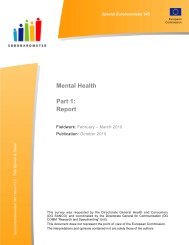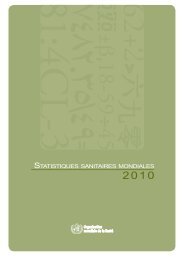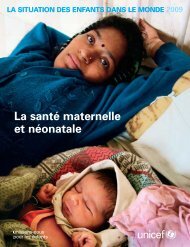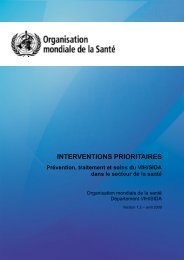Global Tuberculosis Control 2010 - Florida Department of Health
Global Tuberculosis Control 2010 - Florida Department of Health
Global Tuberculosis Control 2010 - Florida Department of Health
Create successful ePaper yourself
Turn your PDF publications into a flip-book with our unique Google optimized e-Paper software.
he World <strong>Health</strong> Organization (WHO) has published<br />
an annual report on global control <strong>of</strong> tuberculosis<br />
(TB) every year since 1997. The main purpose <strong>of</strong> the<br />
report is to provide a comprehensive and up-to-date<br />
assessment <strong>of</strong> the TB epidemic and progress made in TB<br />
care and control at global, regional and country levels.<br />
Progress towards global targets set for 2015 is given particular<br />
attention. The target included in the Millennium<br />
Development Goals (MDGs) is that TB incidence should<br />
be falling by 2015. The Stop TB Partnership has set two<br />
additional targets, which are to halve rates <strong>of</strong> prevalence<br />
and mortality by 2015 compared with their levels in<br />
1990. Collectively, the WHO’s Stop TB Strategy and the<br />
Stop TB Partnership’s <strong>Global</strong> Plan to Stop TB have set<br />
out how the 2015 targets can be achieved.<br />
This fifteenth annual report 1 contains more up-todate<br />
information than any previous report in the series,<br />
following earlier data collection and the completion <strong>of</strong><br />
the production cycle within a calendar year.<br />
The estimates <strong>of</strong> the global burden <strong>of</strong> disease caused<br />
by TB in 2009 are as follows: 9.4 million incident cases<br />
(range, 8.9 million–9.9 million), 14 million prevalent<br />
cases (range, 12 million–16 million), 1.3 million deaths<br />
among HIV-negative people (range, 1.2 million–1.5 million)<br />
and 0.38 million deaths among HIV-positive people<br />
(range, 0.32 million–0.45 million). Most cases were in<br />
the South-East Asia, African and Western Pacific regions<br />
(35%, 30% and 20%, respectively). An estimated 11–13%<br />
<strong>of</strong> incident cases were HIV-positive; the African Region<br />
accounted for approximately 80% <strong>of</strong> these cases.<br />
There were 5.8 million notified cases <strong>of</strong> TB in 2009,<br />
equivalent to a case detection rate (CDR, defined as the<br />
proportion <strong>of</strong> incident cases that were notified) <strong>of</strong> 63%<br />
(range, 60–67%), up from 61% in 2008. Of the 2.6 million<br />
patients with sputum smear-positive pulmonary TB<br />
in the 2008 cohort, 86% were successfully treated.<br />
New and compelling data from 15 countries show that<br />
efforts by national TB programmes (NTPs) to engage all<br />
care providers in TB control (termed public-private mix,<br />
or PPM) can be a particularly effective way to increase<br />
the CDR. In areas where PPM was implemented, non-<br />
NTP providers accounted for around one-fifth to onethird<br />
<strong>of</strong> total notifications in 2009.<br />
In 2009, 26% <strong>of</strong> TB patients knew their HIV status<br />
(up from 22% in 2008), including 53% <strong>of</strong> patients in<br />
the African Region. A total <strong>of</strong> 300 000 HIV-positive TB<br />
patients were enrolled on co-trimoxazole preventive<br />
therapy, and almost 140 000 were enrolled on antiretroviral<br />
therapy (75% and 37% respectively <strong>of</strong> those who<br />
1<br />
Two reports were published in 2009. The and<br />
sections <strong>of</strong> this report explain why this was necessary.<br />
tested HIV-positive). To prevent TB, almost 80 000 people<br />
living with HIV were provided with isoniazid preventive<br />
therapy. This is an increase from previous years, but<br />
still represents less than 1% <strong>of</strong> the estimated number <strong>of</strong><br />
people living with HIV worldwide.<br />
Among TB patients notified in 2009, an estimated<br />
250 000 (range, 230 000–270 000) had multidrugresistant<br />
TB (MDR-TB). Of these, slightly more than<br />
30 000 (12%) were diagnosed with MDR-TB and notified.<br />
Diagnosis and treatment <strong>of</strong> MDR-TB need to be rapidly<br />
expanded.<br />
Funding for TB control continues to increase and will<br />
reach almost US$ 5 billion in 2011. There is considerable<br />
variation in what countries spend on a per patient basis<br />
(US$ 1000), and the extent to which countries<br />
rely on domestic or external sources <strong>of</strong> funds. Compared<br />
with the funding requirements estimated in the<br />
<strong>Global</strong> Plan, the funding gap is approximately US$ 1 billion<br />
in 2011. Given the scale-up <strong>of</strong> interventions set out<br />
in the plan, this could increase to US$ 3 billion by 2015<br />
without intensified efforts to mobilize more resources.<br />
Incidence rates are falling globally and in five <strong>of</strong><br />
WHO’s six regions (the exception is the South-East Asia<br />
Region, where the incidence rate is stable). If these trends<br />
are sustained, the MDG target will be achieved. Mortality<br />
rates at global level fell by around 35% between 1990<br />
and 2009, and the target <strong>of</strong> a 50% reduction by 2015<br />
could be achieved if the current rate <strong>of</strong> decline is sustained.<br />
At the regional level, the mortality target could<br />
be achieved in five <strong>of</strong> WHO’s six regions; the exception<br />
is the African Region (although rates <strong>of</strong> mortality are<br />
falling). Prevalence is falling globally and in all six WHO<br />
regions. The target <strong>of</strong> halving the 1990 prevalence rate<br />
by 2015 appears out <strong>of</strong> reach at global level, but could be<br />
achieved in three <strong>of</strong> six regions: the Region <strong>of</strong> the Americas,<br />
the Eastern Mediterranean Region and the Western<br />
Pacific Region.<br />
Reductions in the burden <strong>of</strong> disease achieved to date<br />
follow 15 years <strong>of</strong> intensive efforts to improve TB care<br />
and control. Between 1995 and 2009, a total <strong>of</strong> 41 million<br />
TB patients were successfully treated in DOTS programmes,<br />
and up to 6 million lives were saved including<br />
2 million among women and children. Looking forwards,<br />
the Stop TB Partnership launched an updated version <strong>of</strong><br />
the <strong>Global</strong> Plan to Stop TB in October <strong>2010</strong>, for the years<br />
2011–2015. In the five years that remain until the target<br />
year <strong>of</strong> 2015, intensified efforts are needed to plan,<br />
finance and implement the Stop TB Strategy, according<br />
to the updated targets included in this plan. This could<br />
save at least one million lives per year.

















